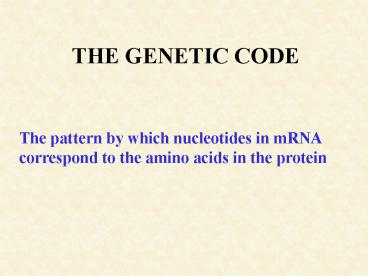THE GENETIC CODE - PowerPoint PPT Presentation
1 / 19
Title:
THE GENETIC CODE
Description:
The pattern by which nucleotides in mRNA correspond to the amino acids ... Codon-anticodon pairing precise only for first. two nucleotides of codon (CGU = Arg) ... – PowerPoint PPT presentation
Number of Views:43
Avg rating:3.0/5.0
Title: THE GENETIC CODE
1
THE GENETIC CODE
The pattern by which nucleotides in mRNA
correspond to the amino acids in the protein
2
Codons in mRNA determine amino acid sequence in
protein
- mRNA sequence corresponds directly to aa sequence
in the polypeptide
3
Nucleotides to Amino Acids
- How many nucleotides are needed to specify 20
different amino acids? - If 1 nucleotide 41 unique combinations
- If 2 nucleotides 42 unique combinations
- If 3 nucleotides 43 unique combinations
4
Fig. 12.7 The genetic code
- 61 codons for 20 amino acids (sense codons)
- Three codons do not specify amino acids
(nonsense, or stop codons) - By convention, a codon is written as it appears
in mRNA, reading in the 5 to 3 direction
5
Characteristics of the Genetic Code
- a. It is a triplet code. Each three-nucleotide
codon in the mRNA specifies one amino acid in the
polypeptide. - b. It is comma free. The mRNA is read
continuously, three bases at a time, without
skipping any bases. - c. It is non-overlapping. Each nucleotide is part
of only one codon, and is read only once during
translation. - d. It is almost universal. In nearly all
organisms studied, most codons have the same
amino acid meaning. - http//www.ncbi.nlm.nih.gov
6
Characteristics of the Genetic Code
- e. It is degenerate. 18 of 20 amino acids are
encoded by more than one codon. Met (AUG) and Trp
(UGG) are the exceptions. Codon sets often show a
pattern in their sequences (ex. variation in 3rd
position). - f. The code has start and stop signals. AUG is
the usual start signal for protein synthesis.
There are generally three stop codons
7
The Reading Frame for Translation
Ribosomes bind at or near 5' end of
mRNA Initiation (start) codon is AUG
(Methionine) -downstream from 5' end of
mRNA -codes for first amino acid in
polypeptide Translation of initiation codon
AUG Prokaryotes Eukaryotes
8
Genetic code is nonoverlapping, with no
intervening nucleotides
AUG first codon Next triplet is next codon Last
amino acid in polypeptide is the triplet before
the termination codon Termination codons do not
code for aa At termination codon, ribosomes
separate from RNA 5 AUG UUU GGU CCGACU UAA 3
9
Characteristics of the Genetic Code
- g. Wobble occurs in the anticodon. The 3rd (3)
base in the codon is able to base-pair less
specifically to 5 end of anticodon, because
bonding in this position is less constrained
three-dimensionally.
Fig. 12.8 Example of base-pairing wobble
10
Degeneracy and Wobble
With 61 mRNA codons, there could be 61
tRNAs Wobble hypothesis (Francis Crick),
Codon-anticodon pairing precise only for first
two nucleotides of codon (CGU Arg) The 5'
end of anticodon allows wobble pairing One tRNA
anticodon can recognize several codons
11
Base-pairing rules at third codon according to
wobble hypothesis
5' Nucleotide 3'Nucleotide in
Anticodon(tRNA) in Codon (mRNA) G pairs with
U or C C pairs with G A pairs with U U
pairs with A or G I pairs with U, C, or A
(Table 12.1)
Inosine (I) -Similar to guanine but lacks
amino group attached to no. 2 carbon Wobble
rules reduce tRNAs (anticodons) needed to
complement 61 codons
12
Wobble Base Pairing
DNA mRNA(codon) tRNA(anticodon)
13
5' Nucleotide 3'Nucleotide in Anticodon(tRNA) in
Codon (mRNA) G pairs with U or C C pairs with
G A pairs with U U pairs with A or G I pairs
with U, C, or A
Wobble Base Pairing
G doesnt pair w/I AUG codon is only
recognized by UAC anticodon not UAI
14
Translation The Process of Protein Synthesis
- Ribosomes translate the genetic message of mRNA
into proteins - 2. The mRNA is translated 5 to 3 and
polypeptide is made in N-terminal to C-terminal
direction - 3. Amino acids bound to tRNAs are inserted in
the proper sequence due to - a. Specific binding of each amino acid to its
tRNA(s) - b. Specific base pairing between the mRNA codon
and tRNA anticodon
15
Formation of a charged tRNAby aminoacyl tRNA
synthetase
- Aminoacyl-tRNA synthetase attaches amino acids to
their specific tRNA molecules. The charging
process - There are 20 different aminoacyl-tRNA synthetase
enzymes, one for each amino acid. Some of these
enzymes recognize tRNAs by their anticodon
regions, and others by sequences elsewhere in the
tRNA
16
Molecular details of the attachment of an amino
acid to a tRNA molecule
- Aminoacyl bond between
17
Formation of a charged tRNAby aminoacyl tRNA
synthetase
- Step 1
- Amino acid ATP aminoacyl-AMP
Fig. 12.9 Charging of a tRNA molecule by
aminoacyl-tRNA synthetase to produce an
aminoacyl-tRNA (charged tRNA)
18
Formation of a charged tRNAby aminoacyl tRNA
synthetase
Step 2 activated aa tRNA charged
(aminoacyl) tRNA AMP is released
19
Cognate or isoaccepting tRNAs
- Each tRNA binds to only one type of aa, but
- Different tRNAs (differing in anticodon seq) can
carry the































